Types of rooflight explained — a guide to choosing the best style for your home
Explore the most popular types of rooflight for residential homes and learn how to choose the best style for your space
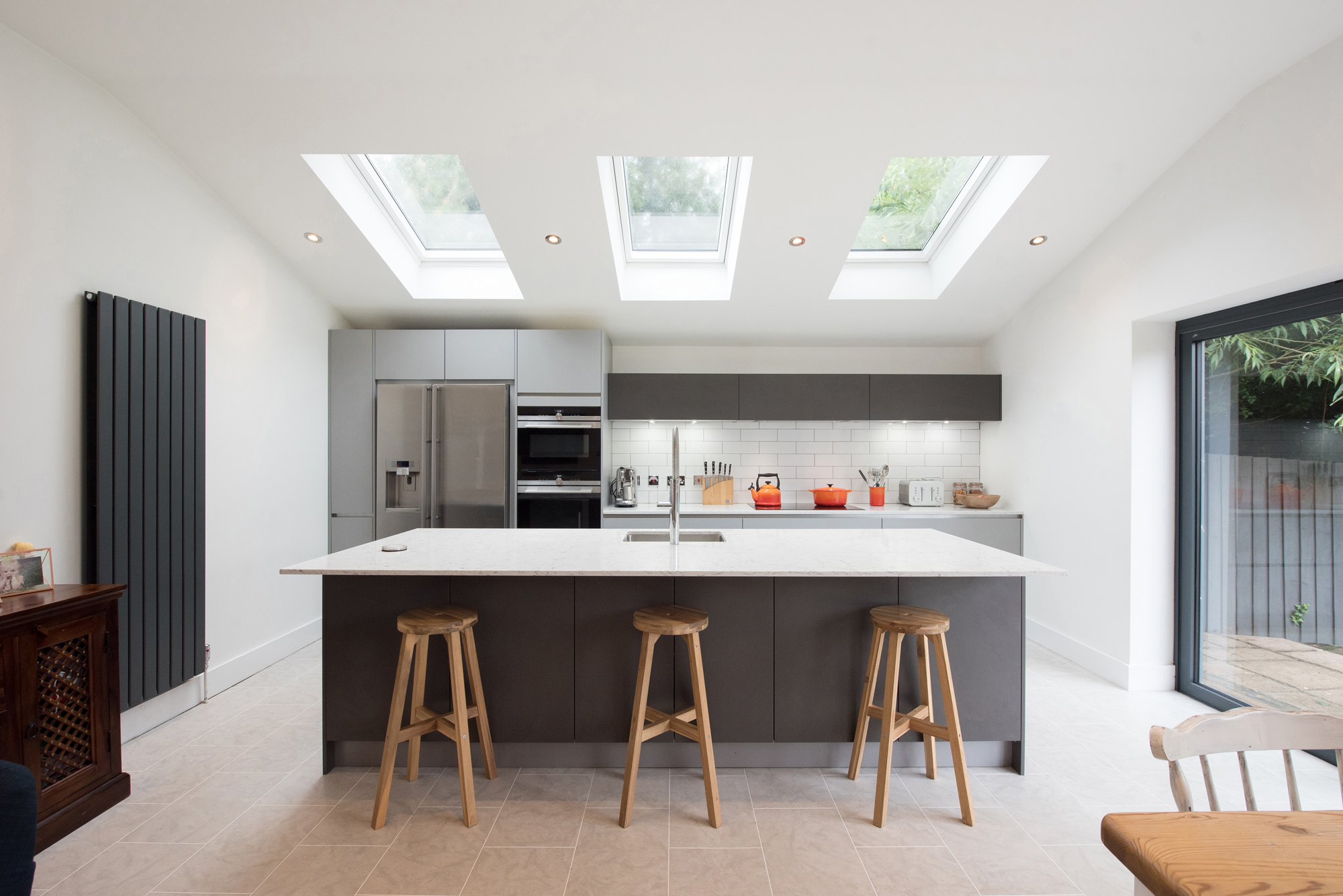
If your home feels dim or enclosed, installing a rooflight can make all the difference. These clever home additions can lift the mood of a room, make small spaces feel bigger, and add architectural interest without the need for major structural work.
Different rooflight styles offer different advantages, from modern, barely-there flat glass designs to bold lanterns that make a feature of your ceiling. Some are ideal for loft conversions or modern extensions, while others work beautifully in period homes, where character and conservation rules matter.
In this guide, we’ll walk you through the most common types of rooflight used in homes today. You’ll also find expert tips on choosing the right option for your roof setup, plus practical pointers on installation, costs and upkeep, so you can be confident with your decision.
Common types of rooflight explained
Ceiling glazing is one of the smartest ways to bring extra light into your home, especially in rooms where wall space for windows is limited. But when choosing a rooflight, the style you opt for can make a big difference to both how it looks and how it works.
“The main types of rooflights you’ll be likely to consider are flat glass rooflights and roof lanterns,” explains Kevin Brown, managing director of The Heritage Window Company. “Flat glass rooflights sit almost level with the roof, offering a more minimalist aesthetic – whereas roof lanterns are raised with multiple panes.”
While these two are among the most popular choices, they’re just the beginning. Here are the 5 most common types of rooflight and what to consider for each:

Kevin Brown is director of The Heritage Window Company, specialists in steel-look aluminium windows that blend period aesthetics with modern performance for conservation, renovation and bespoke new-build projects.
Common types of rooflight
Flat Glass Rooflights
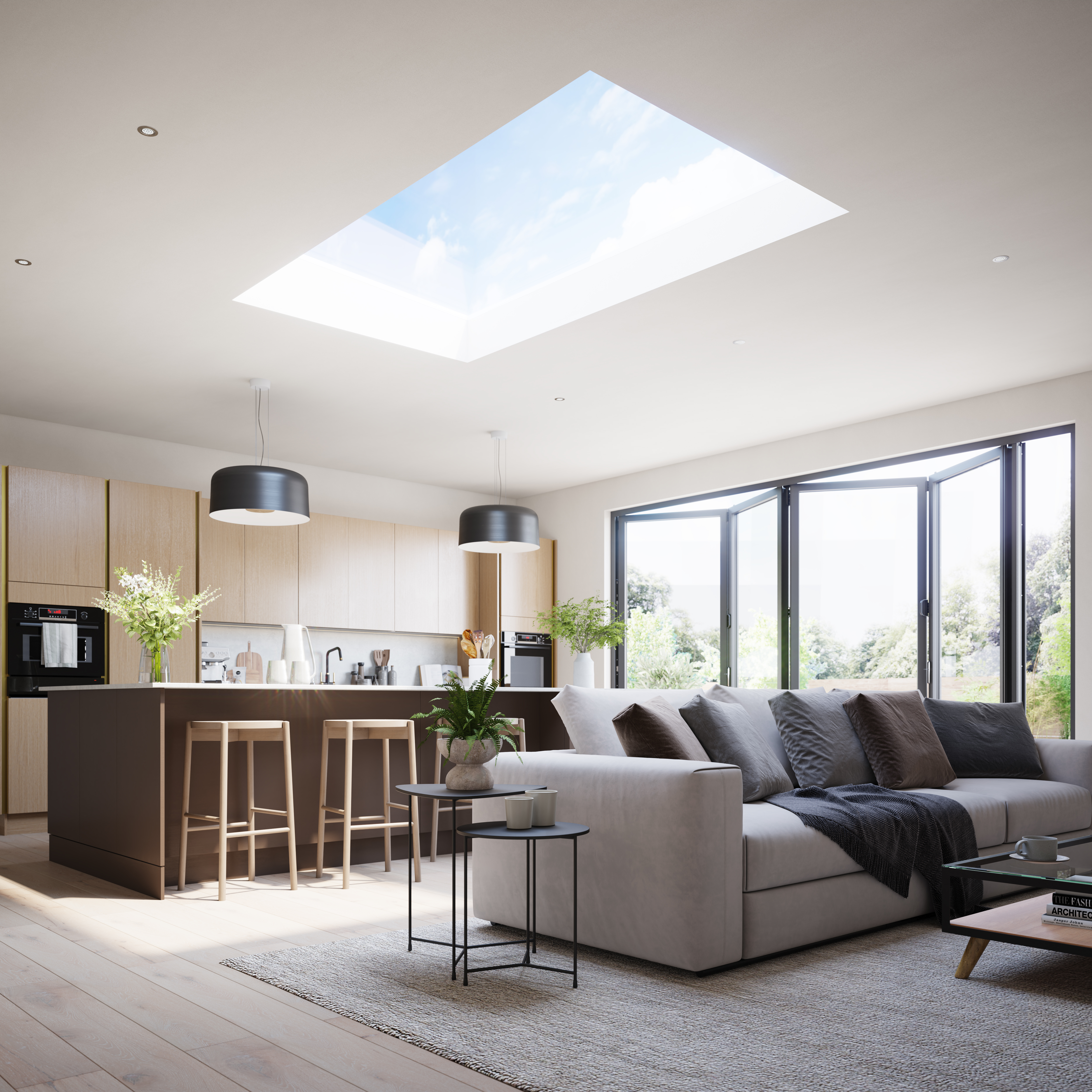
Flat glass rooflights are a favourite in modern homes, especially in single-storey extensions or loft conversions where wall glazing is limited. Sitting almost level with the roofline, they offer a clean, minimalist look that brings in maximum daylight without disrupting your home's architecture.
Bring your dream home to life with expert advice, how to guides and design inspiration. Sign up for our newsletter and get two free tickets to a Homebuilding & Renovating Show near you.
“Flat roof extensions typically include flat glass or roof lanterns,” explains Mike Storey, manager at UKFR Roofing & Insulation. “But flat glass is the more popular choice thanks to its sleeker, more contemporary appearance.”
Beyond looks, these rooflights excel at drawing in uninterrupted bands of natural light, which is a real advantage in darker or more compact spaces. Shapes like long, narrow rectangles can channel light like a beam, while rounded styles create playful pools of brightness that move with the sun.
Frameless designs are increasingly popular for their ultra-modern aesthetic. With no visible internal frame, they blend almost seamlessly into the ceiling. But that sleekness can sometimes come at a cost. “Many frameless designs also lack mechanical fixings and rely solely on silicone to stay in place, which poses risks,” warns Mike Storey. They can also be more prone to leaks and condensation build-up between panes, so it pays to do your homework.
Mike recommends checking the glazing build-up as a top priority. Look for laminated inner panes rather than toughened glass alone. “If toughened glass breaks, it shatters completely, potentially causing glass to fall into the space below,” he says. “In contrast, laminated glass holds together like a car windscreen, significantly improving safety.”
Best for: Modern extensions, kitchens, bathrooms, hallways.
Consider if you want: A clean-lined, low-profile rooflight that blends in.
Watch out for: Frameless models with poor sealing or minimal safety features.

Mike Storey is aManager at UK Flat Roofing and Insulation Specialists, which provides a variety of flat roofing and construction supplies in Manchester and across the UK. UK Flat Roofing was founded in 2014 and is now one of the largest roofing and insulation specialists in the country.
Roof lanterns
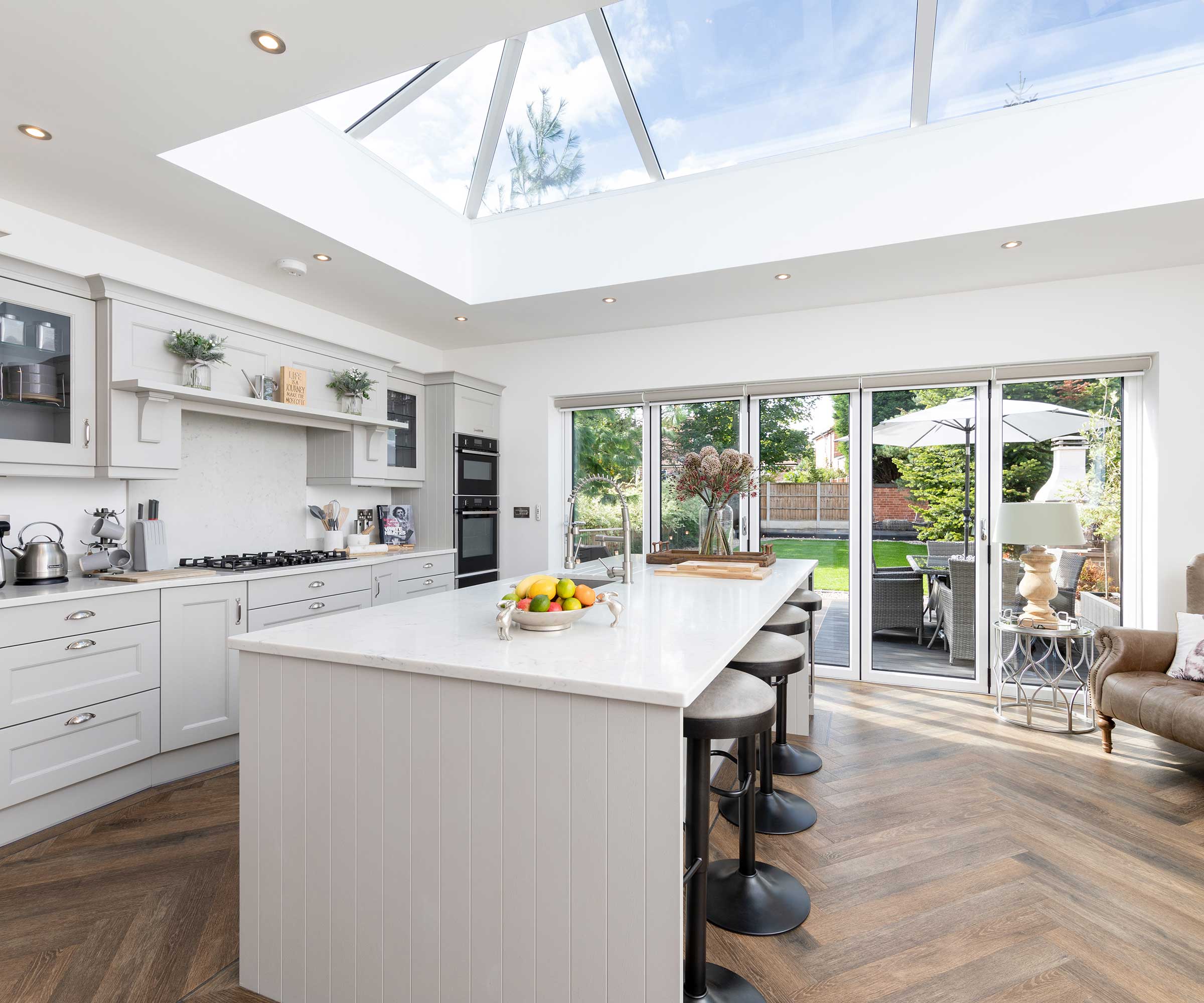
If you want your ceiling glazing to make a statement, a roof lantern is hard to beat. Unlike flat rooflights, which tend to disappear into the architecture, lanterns are all about height and drama. They work particularly well on flat roof extensions with vaulted ceilings beneath, or in orangery-style builds where you want to bring the outdoors in without compromising insulation.
“Roof lanterns are raised with multiple panes,” explains Kevin Brown from The Heritage Window Company. “They offer a more classic aesthetic and work beautifully in larger spaces where you want to make the glazing a feature.”
The segmented design of a roof lantern naturally breaks up the light, creating patterns and reflections – ideal if you’re looking to add atmosphere rather than just illumination. They’re also well suited to older properties like Victorian homes, where their traditional form aligns with period features.
Practical considerations do come into play. Lanterns are rarely pre-assembled, so installation can be more involved (and is often more expensive). It’s also crucial to check the height and placement carefully, especially on single-storey additions, as they can partially block first-floor windows above. On the plus side, the sloped glazing sheds rainwater more effectively, helping to keep the glass cleaner for longer.
If you love the impact of a lantern but want something with a bolder, more geometric edge, pyramid rooflights are worth a look. These four-sided structures offer a similar light-spreading effect, but with a sharp, angular silhouette. “Pyramid rooflights come in a pyramid shape to add architectural interest to a room,” explains Liam Spencer, owner of Northallerton Glass. “They’re most commonly used in commercial buildings to create a focal point, but can be equally effective in the right residential setting.”
Whichever shape you go for, just remember that lantern-style rooflights require an upstand — typically around 150mm — so it’s important to check that your roof build-up can accommodate one.
Best for: Large open-plan spaces, vaulted ceilings, orangeries
Consider if you want: A dramatic, light-filled feature that acts as a focal point
Watch out for: Upstand requirements, higher install costs, and potential obstruction to first-floor windows

The owner of Northallerton Glass, Liam has a decade of experience in the glass processing and glazing industry. He enjoys sharing his wide range of knowledge on domestic glass choices.
Conservation & heritage rooflights
Conservation rooflights are designed to blend with period properties and meet the requirements of listed buildings or homes in conservation areas. They typically sit flush to the roof and feature slim metal frames with glazing bars that echo traditional designs. They’re ideal for loft conversions or subtle extensions where preserving the home’s character is key. “Traditional” doesn’t mean basic though. Many models now offer double glazing, opening mechanisms and energy-efficient performance.
These rooflights are available in fixed or opening formats for pitched or low-pitch roofs. Just be sure to check whether planning consent or listed building approval is needed before going ahead.
Best for: Listed buildings, period homes, conservation areas
Consider if you want: A discreet, heritage-appropriate design
Watch out for: Planning restrictions
Walk-on rooflights
Walk-on rooflights are exactly what they sound like: structural glass panels that can be safely walked over. They're commonly used on flat roofs or balconies where you want to let in natural light to the room below without losing usable outdoor space.
These rooflights are built with toughened or laminated glass and often feature an anti-slip surface for added safety. They’re a smart solution for basement conversions where you want to capture every drop of daylight. Just bear in mind they tend to be more expensive than standard models, and installation must comply with structural and building regs, so always work with an experienced supplier.
Best for: Terraces, balconies, flat roofs above living spaces
Consider if you want: Light below without compromising floor space above
Watch out for: Higher costs and the need for structural support
Ridge rooflights
Ridge rooflights are fitted at the highest point of a pitched roof – where the two slopes meet – and are brilliant for bringing in top-down light across the full width of a room. Because they sit along the ridge line, they create a symmetrical, balanced look and are often used to highlight vaulted ceilings or open-plan spaces with a dramatic roof structure.
They’re particularly effective in new builds or large-scale renovations where the roof design can accommodate them. Most models offer a frameless internal view for that ‘wow’ effect, and because they sit at the apex, they draw light from both sides of the pitch, helping to brighten deeper spaces throughout the day.
Best for: Vaulted ceilings, large open-plan spaces, new builds with pitched roofs
Consider if you want: A sleek glazing feature that maximises natural light at the highest point of your home
Watch out for: Structural requirements – they’re not a retrofit-friendly option
Fixed vs Opening Rooflights: What’s the Difference?
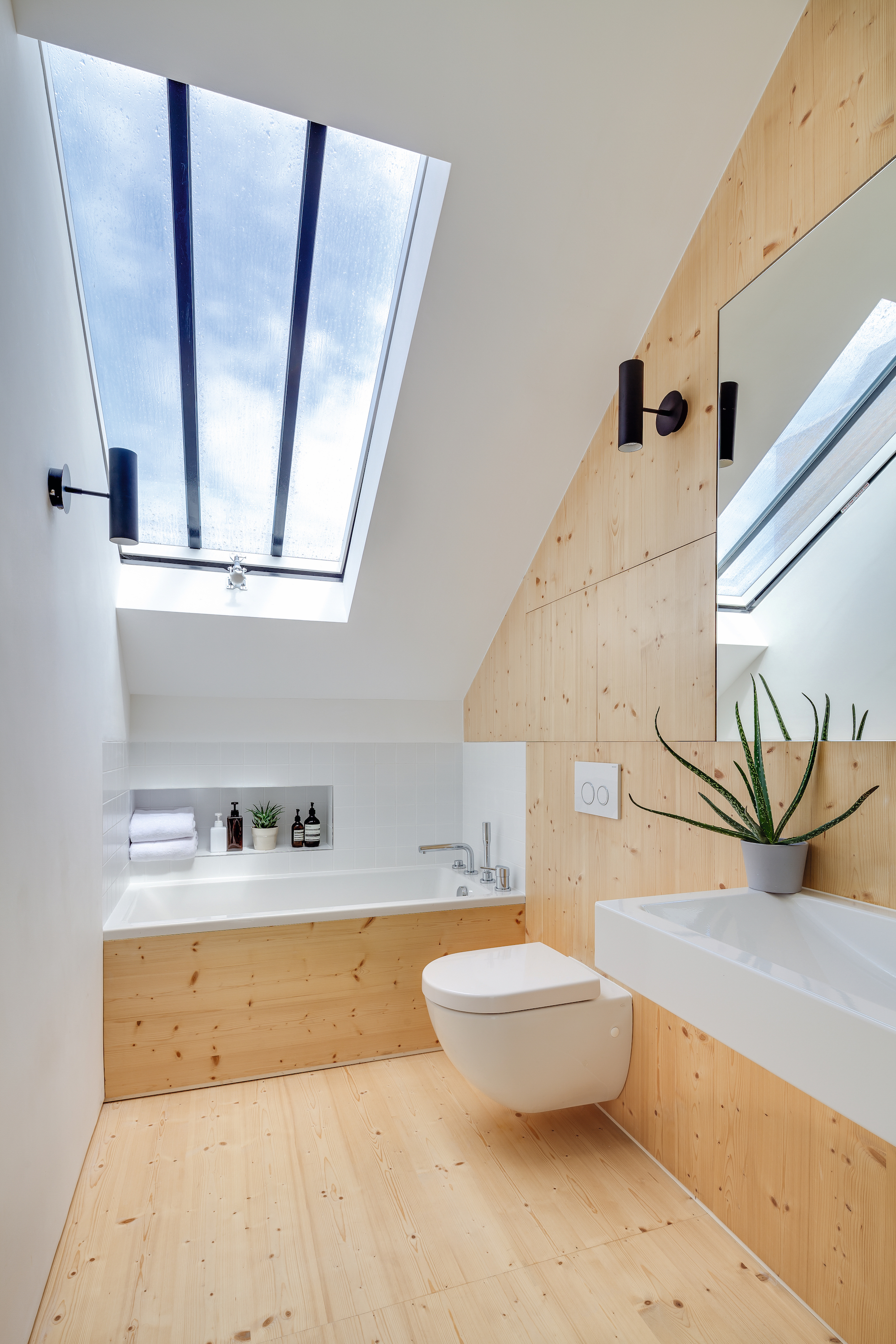
While some rooflights are purely there to let in light, others can also help with ventilation and choosing between a fixed or opening model depends largely on how you use the space.
“Fixed rooflights are usually sealed units that do not open, and are used to provide an additional source of daylight to the room below,” explains Liam Spencer, owner of Northallerton Glass. “They are best suited for areas where ventilation is not a large concern, such as hallways or corridors.”
Opening rooflights, on the other hand, can do both jobs at once, bringing in natural light while helping to circulate fresh air. “They are a better choice for rooms like kitchens or lofts, as they can increase air circulation,” says Liam. “If the ability to open the rooflight is an issue, opening rooflights can be electric or manual, making them adaptable to the specific needs of your home.”
In spaces prone to humidity or heat build-up, like bathrooms, kitchens and lofts, an opening rooflight is often the most practical choice. In areas where light is the priority and airflow isn’t essential, a fixed rooflight is typically more affordable and lower maintenance.
Which type of rooflight to choose
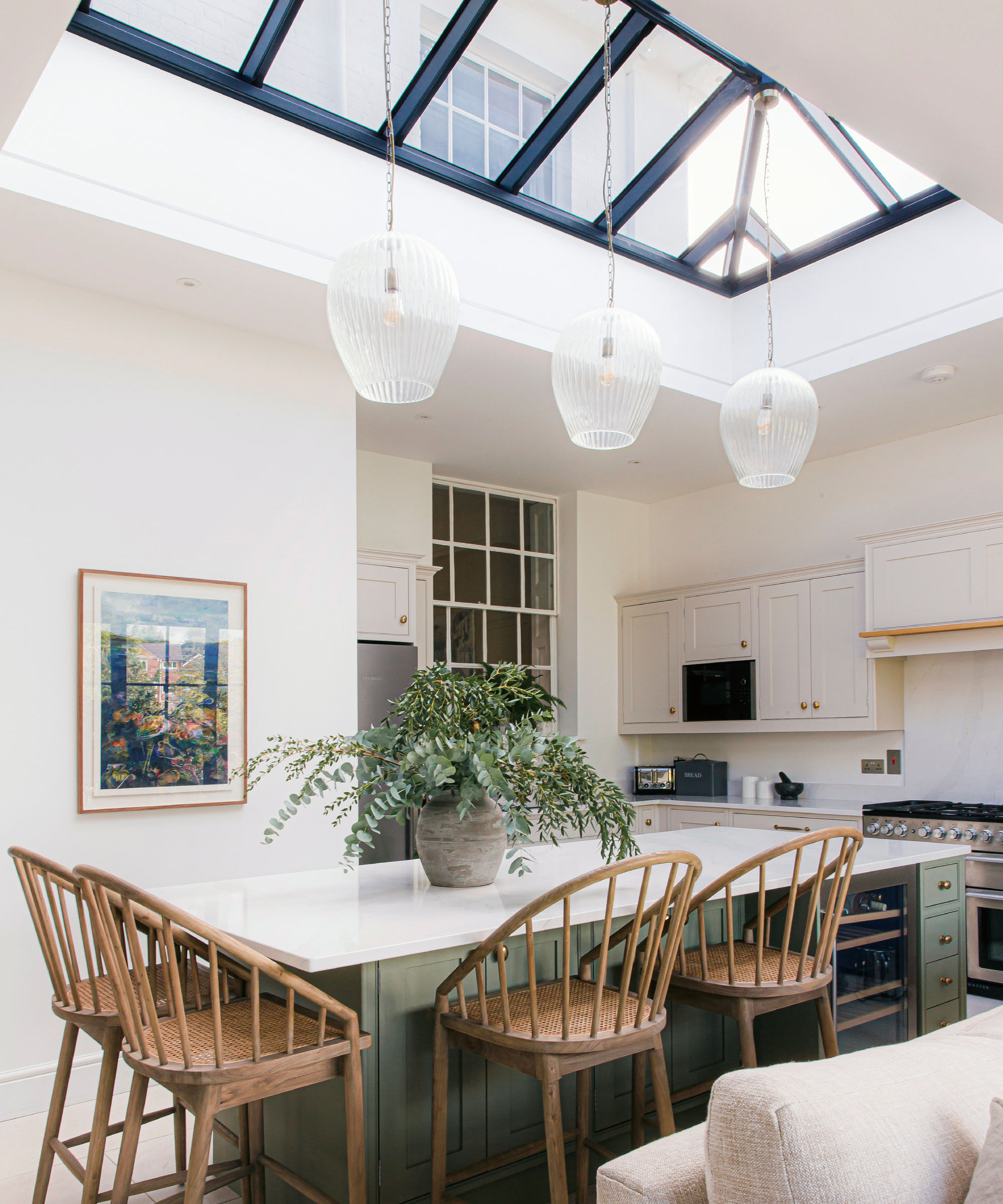
When selecting the right rooflight for your home you’ll need to factor in the type of roof you have, what the space is used for, and how much light and ventilation you need day to day. Here's what to consider:
Think about your roof type
The type of roof you have may dictate the type of rooflight you can install. For example, certain rooflights are designed specifically for flat roofs, like lanterns, frameless panels and walk-on glass. Others — such as VELUX-style roof windows or conservation rooflights — are made for pitched roofs, where they sit in line with the existing tiles.
“For spaces with a flat roof, you will need to check that the roof is structurally sound before you can consider installing a rooflight,” advises Liam Spencer. “You will also need to look specifically for a rooflight that will prevent water pooling and ensure that there is a proper drainage system in place. Most flat roof rooflights will have a very small pitch, often no more than 15 degrees, as this will ensure water runoff and stop water pooling around the rooflight.”
Match the style to the room’s function
The right rooflight should complement how your room works. In busy, functional spaces like kitchens and bathrooms, opt for styles that boost both light and ventilation. Flat glass rooflights are ideal here, as they sit almost flush with the roofline and can be paired with opening mechanisms to help control humidity and airflow.
For larger or more sociable spaces, a roof lantern can work as a dramatic focal point. Its raised, pitched structure will floods the room with light and create a sense of height and grandeur (which looks especially effective over dining tables or kitchen islands).
In circulation spaces such as hallways or stairwells, long, narrow rooflights can channel daylight like a lightwell, while circular options create eye-catching pools of light.
Don’t forget the proportions and finishes
Getting the size and style of your rooflight right can make all the difference. “In order to provide a good amount of light, a rooflight should cover 5% to 15% of the floor area of a room,” explains Liam Spencer. “Spacious rooms may need more than one rooflight for better light distribution.”
It’s also worth considering how the frame finish complements your home’s character. Aluminium or frameless styles tend to suit more contemporary builds, while metal-framed rooflights with glazing bars are ideal for period properties or homes in conservation areas, as they offer a traditional appearance with modern thermal performance.
FAQs
How do I choose the best place to install a rooflight?
“For kitchens specifically, consider where you want the light to hit in the room when choosing where to install it,” says Liam Spencer, owner of Northallerton Glass. “For example, strategically placing a rooflight over a kitchen workspace can reduce the need for artificial lighting.”
The direction your roof faces also matters. South-facing rooflights will let in the most daylight, but also more heat. North-facing options offer more consistent, diffused light throughout the day.
“It may sound simple, but when choosing the right rooflight, you should also make sure the size and shape of your kitchen roof or loft can accommodate the style of rooflight you’re after,”adds Kevin Brown of The Heritage Window Company. “You need to allow for a 150mm upstand on the design of the roof. If this isn’t possible, you’ll have to start looking for alternatives.”
Do I need to think about insulation and sealing?
Yes, and it’s just as important as choosing the style or size of your rooflight. Poor insulation can lead to heat loss in winter and overheating in summer, so it’s worth paying attention to both the glazing and the frame.
“A rooflight with high-quality insulated frames can prevent heat loss through the glazing and frame,” explains Liam Spencer, owner of Northallerton Glass. “UPVC and aluminium are both good choices, provided they’re thermally broken to avoid cold bridging.”
Liam also highlights the importance of professional sealing and weatherproofing: “Flashing should be installed around the edges of the rooflight to divert water away and prevent water ingress.” Without it, even a well-made rooflight could let in draughts or moisture over time.
Glazing matters, too. “Opting for double or triple glazing can help reduce heat loss and also limit solar gain,”adds Liam. "This is particularly important in south-facing spaces or rooms with large expanses of glass, where too much sunlight can lead to uncomfortable temperature spikes."
Need to control light or boost insulation? Check out our guide to the best skylight blinds, from blackout options for bedrooms to solar-powered designs that make high-up windows easy to manage.

Gabriella is an interiors journalist and has a wealth of experience creating interiors and renovation content. She was Homebuilding & Renovating's former Assistant Editor as well as the former Head of Solved at sister brand Homes & Gardens, where she wrote and edited content addressing key renovation, DIY and interior questions.
She’s spent the past decade crafting copy for interiors publications, award-winning architects, and leading UK homeware brands. She also served as the Content Manager for the ethical homeware brand Nkuku.
Gabriella is a DIY enthusiast and a lover of all things interior design. She has a particular passion for historic buildings and listed properties, and she is currently in the process of renovating a Grade II-listed Victorian coach house in the West Country.
